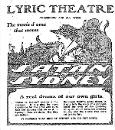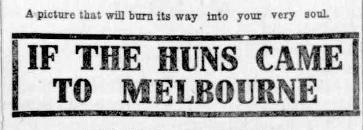AustLit
Latest Issues
AbstractHistoryArchive Description
'Betty Benton, step-sister of Anne Maxwell, discloses to Anne's father that she had overheard Anne agree to proceed an hour earlier than the regular time to receive extra lessons from choir-master Karl Krona, whose sympathies are all with the German cause. Mr Maxwell, with a vestryman and the minister of the church, visit the church and witness Krona embracing and attempting to kiss Anne against her will. Krona is dismissed from his position on the spot, and the stern father orders Anne to leave his home. Anne decides to earn her own living in Sydney. Early In her career in the city, she encounters Satan, typified by Karl Krona, who wants the girl. Anne has been followed to Sydney by her lover, Will Wayburn, by whom she is rescued from a house of evil repute, after a rough up with the bully of the establishment, and also saved from the clutches of the arch-fiend Krona in a Chinese opium-smoking joint. Wayburn heads a squad of A.I.F. boys in khaki in effecting his second rescue. Anne has been lured to that den by a false note from her step-sister, who was in Krona's power, the idea being to prevent her going on service as a nursing sister. Rescued in time to join the transport, Anne reaches the front in France, and one of her first charges in the field hospital is Wayburn. Eventually all ends brightly. Wayburn and Anne marry; Maxwell pere begs his daughter's pardon; the flirtatious Betty mends her ways; Krona, the villain, is interned; and while yet on their honeymoon the happy Wrayburn pair do their bit towards recruiting.'
Source:
'Satan in Sydney', Townvsille Daily Bulletin, 28 December 1918, p.3
Publication Details of Only Known VersionEarliest 2 Known Versions of
Works about this Work
-
National Versions of the Great War : Modern Australian Anzac Cinema
2014
single work
criticism
— Appears in: The Great War in Post-Memory Literature and Film 2014; (p. 289-304) -
Convention and Contradiction : Representations of Women in Australian War Films, 1914–1918
1999
single work
criticism
— Appears in: Australian Historical Studies , October vol. 30 no. 113 1999; (p. 215-230)'This paper examines the representation of women in Australian cinematic war dramas made between 1914 and 1918, showing how the representations were shaped by political, industrial and ideological influences and identifying the range of representations present in the films. It observes that while there was considerable overlap with other media in the representation of women, there were images ignored by films, while others were unique to the cinema.'
Source: Abstract.
-
Convention and Contradiction : Representations of Women in Australian War Films, 1914–1918
1999
single work
criticism
— Appears in: Australian Historical Studies , October vol. 30 no. 113 1999; (p. 215-230)'This paper examines the representation of women in Australian cinematic war dramas made between 1914 and 1918, showing how the representations were shaped by political, industrial and ideological influences and identifying the range of representations present in the films. It observes that while there was considerable overlap with other media in the representation of women, there were images ignored by films, while others were unique to the cinema.'
Source: Abstract.
-
National Versions of the Great War : Modern Australian Anzac Cinema
2014
single work
criticism
— Appears in: The Great War in Post-Memory Literature and Film 2014; (p. 289-304)
- Sydney, New South Wales,





